As a business owner, you’ve worked hard to build your company. Whether you’re fine-tuning products and services, building relationships with customers, or educating your staff, keeping on top of it all can often feel like you’re spinning plates.
With so many tasks to handle, it can be easy to forget the importance of protecting your property from costly damage such as floods, mold, vandalism and more.
Whether you own or lease your property, it’s your duty to keep your business environment safe, and even if you’re lucky enough to employ a facility manager or caretaker, the ultimate responsibility for preventing disaster falls on you.
Here are six key areas to focus on as you work to improve the safety of your workspace and prevent the risk of commercial property damage.
1. Fix Those Leaks
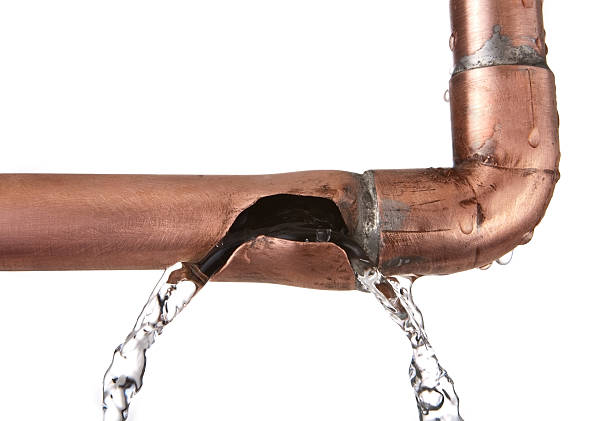 Water damage is one of the most common and costliest types of commercial property damage. A single burst pipe can cost your business thousands of dollars if left unattended. Even if the source of the leak is fixed quickly, the resulting spread of water can cause structural damage in walls and foundations, ruin carpets, fixtures and possessions, and lead to the growth of harmful mold. This can also lead to temporary closure of the business, resulting in lost revenue.
Water damage is one of the most common and costliest types of commercial property damage. A single burst pipe can cost your business thousands of dollars if left unattended. Even if the source of the leak is fixed quickly, the resulting spread of water can cause structural damage in walls and foundations, ruin carpets, fixtures and possessions, and lead to the growth of harmful mold. This can also lead to temporary closure of the business, resulting in lost revenue.
Fortunately, there are several steps a business owner can take to significantly reduce the risk of water leaks. First and foremost, know where your main shutoff valve is. In the event of a major leak, turning off this shutoff valve as soon as possible could reduce the restoration costs by tens of thousands of dollars. You can also install a water leak detection system or smart water main shutoff valve that uses complex algorithms and sensors to alert you to leaks and automatically shut off the main water supply line.
Beyond your main shutoff valve, it’s important to maintain and protect the rest of your pipes. During freezing weather, make sure your spigots and other exposed pipes are covered or insulated to reduce the risk of freezing and breaking. If you’ve ever left a can of drink in a freezer and seen it burst you’ll know why pipes can so easily burst in the wintertime!
You should also clean your gutters frequently, especially in fall when they can become clogged with leaves and other debris. These blockages can cause rainwater to seep into your business space, leading to damp, rot, mold and all kinds of problems.
Lastly, if you use sprinklers in the area outside your business property, make sure they’re well maintained and not spraying water toward the building. Your property can only withstand so much water at a time, and sprinklers are a common source of unwanted leaks and mold issues.
Related resources:
Water Damage Restoration
2. Control Heat and Humidity
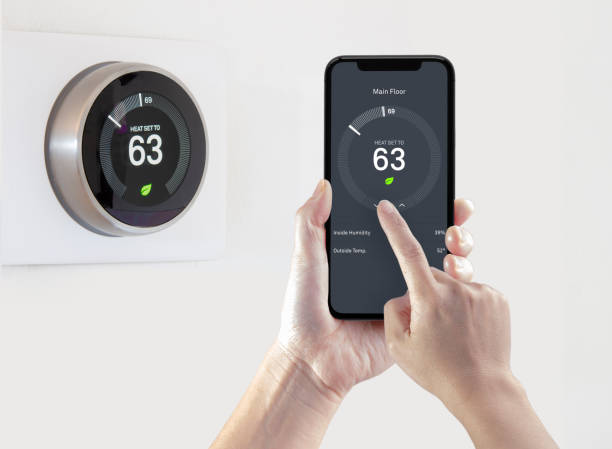 In the grueling summer months, high temperatures and humidity can reduce air quality and create discomfort in the workplace. What’s more, they can cause expensive damage to your building, whether through warped floors, wood rot, mold growth, or a host of other issues.
In the grueling summer months, high temperatures and humidity can reduce air quality and create discomfort in the workplace. What’s more, they can cause expensive damage to your building, whether through warped floors, wood rot, mold growth, or a host of other issues.
There are various steps you can take to control the heat and reduce humidity in your office or facility. These include:
- Use a humidifier or air conditioning system. Humidity should always be lower than 50° (the sweet spot is between 30° and 50°).
- Make sure the workplace is always dry and that any spills are dried up quickly and thoroughly. It only takes mold a day or two to start growing in damp areas.
- Properly ventilate the building by opening windows and doors. This will allow air to move freely throughout the business space. Do not open windows when the air is humid outside.
- You can also improve ventilation by creating space between furniture and walls.
- If your space has a kitchen, showers or any moisture-generating appliances, be sure to use fans to reduce condensation.
Related resources:
5 Ways to Improve Air Quality in Your Home
9 Ways To Keep Your Home Safe in Summer
3. Protect Against Storms and Blizzards
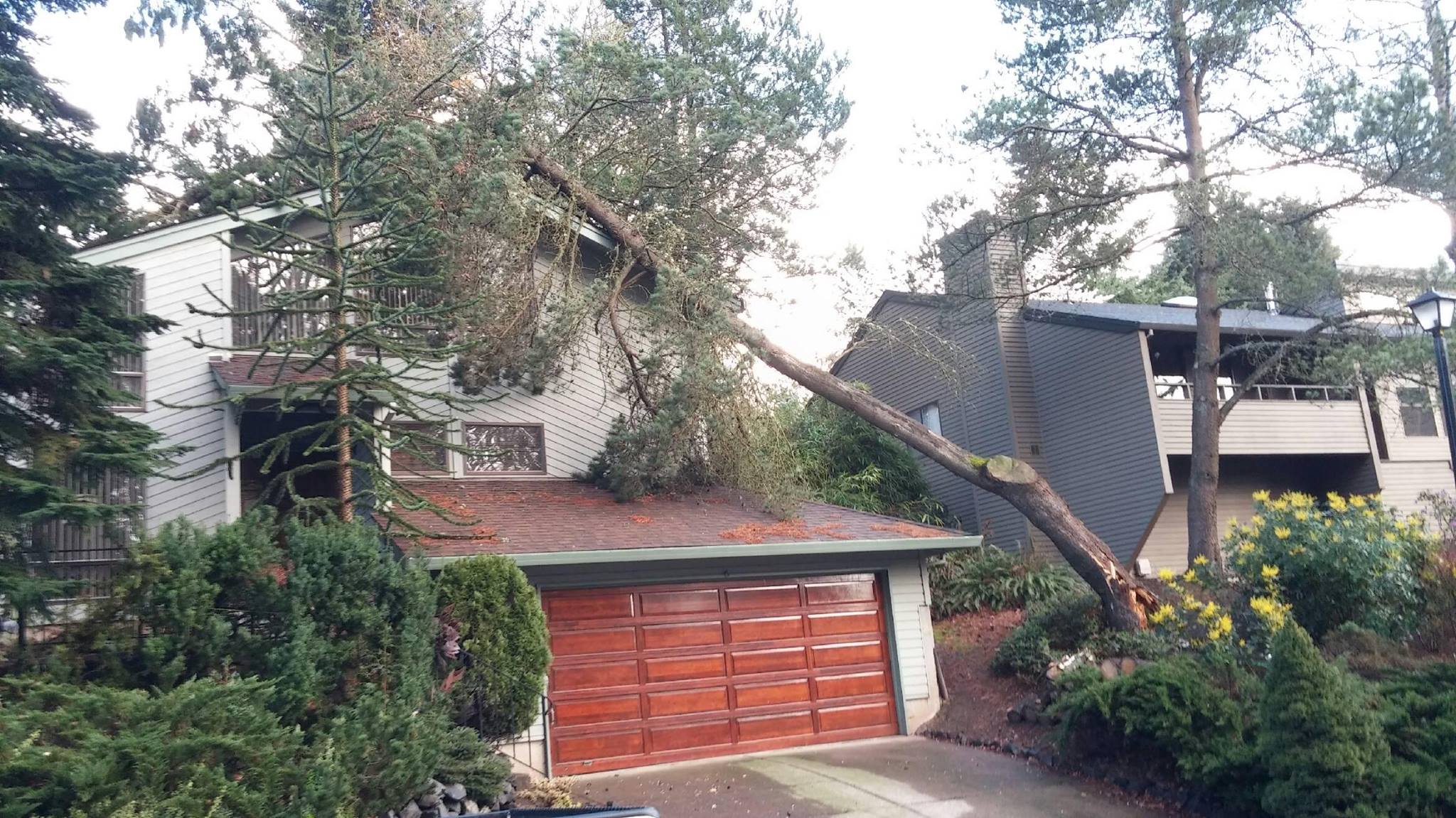
 Storms, blizzards, hurricanes and other strong wind events can occur suddenly and lead to severe consequences, including water intrusion, moisture, mold, mildew, rot and poor air quality. Strong winds can cause trees and power lines to fall, potentially causing massive and costly damage to your home. Storms can also cause sea levels to rise – an effect known as “storm surge” – which can leave your business vulnerable to severe flooding if you live near the coast.
Storms, blizzards, hurricanes and other strong wind events can occur suddenly and lead to severe consequences, including water intrusion, moisture, mold, mildew, rot and poor air quality. Strong winds can cause trees and power lines to fall, potentially causing massive and costly damage to your home. Storms can also cause sea levels to rise – an effect known as “storm surge” – which can leave your business vulnerable to severe flooding if you live near the coast.
One way to reduce the risk of storm damage is by properly protecting your windows. While plywood is an option, it can easily rot, making it viable for only one storm. We recommend getting storm shutters installed instead, as these are more durable and can last through multiple storms.
Outside your business space, you should trim trees and remove exterior debris that might become a hazard during strong winds. Have a professional logging team remove dangerous trees, and anchor outdoor items such as benches to the ground. If you’re located in a flood zone, consider installing flood gates to prevent water from coming into the business space.
Related resources:
Storm Safety Checklist
How to Prepare Your Property for a Hurricane
Wind and Storm Damage Restoration
4. Secure Your Space Against Arson and Vandalism

 Vandals, arsonists and burglars will target commercial properties for various reasons, and almost any business is a potential victim.
Vandals, arsonists and burglars will target commercial properties for various reasons, and almost any business is a potential victim.
Bright lights are often a strong deterrent for would-be criminals. Install motion-sensing lights both indoors and out, and use timers to keep lights shining even while the business is closed.
Make sure your doors have heavy-duty deadbolt locks, and the doors themselves are made from solid-core wood or metal. Security cameras and security fences can provide added protection.
One final area of protection are your windows. Perforated vinyl graphics – usually available from your local signage provider – can provide added privacy to your windows, preventing criminals from easily seeing the contents inside, but still allowing daylight in for the occupants. Windows can also be covered in burglar-resistant glazing for reinforced security.
5. Inspect, Inspect, Inspect!
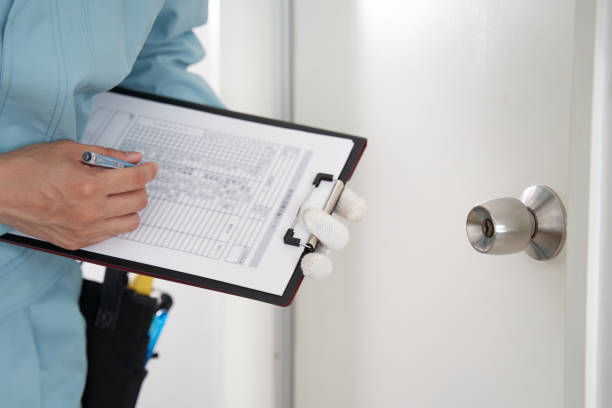
 If the best cure is prevention, the best prevention is inspection! Have a licensed professional inspect your HVAC, plumbing and electrical systems at least once per year, if not quarterly. A licensed restoration provider such as STOP Restoration can inspect your space for mold, leaks, water damage and other property damage hazards.
If the best cure is prevention, the best prevention is inspection! Have a licensed professional inspect your HVAC, plumbing and electrical systems at least once per year, if not quarterly. A licensed restoration provider such as STOP Restoration can inspect your space for mold, leaks, water damage and other property damage hazards.
You or your caretaker should also put regular inspections on your calendar for the following:
- Appliances – Check that machines are spaced apart to avoid overheating. If a machine is connected to your water supply, check its supply lines for cracks and leaks. Any appliances that create moisture (ovens, washing machines, showers, etc) should be in a well-ventilated space (or accompanied by fans).
- Pipes – Check pipes for leaks or signs of damage. Pay particular attention to spigots and pipes exposed to the elements, as these are most susceptible to damage, especially during inclement weather.
- Leaks and Cracks – Walk around your entire property and check walls, ceilings and foundations for cracks or signs of water damage. Note that peeling or warped paint could be a sign of hidden water damage.
- Smoke Alarms – These should be inspected monthly.
We also recommend checking your insurance coverage annually to make sure you’re adequately covered for potential damage. Keep in mind that repair costs can fluctuate depending on the market, and your coverage should ideally account for such changes.
6. Download STOP’s Commercial Property Maintenance Checklist
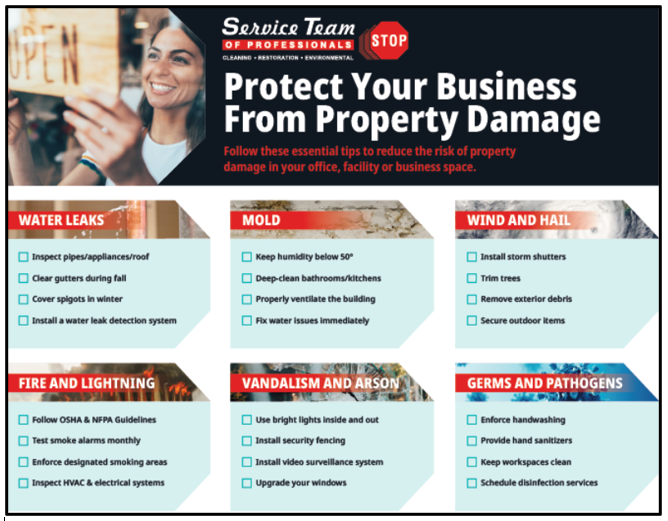 As a business owner, implementing all the above tips might feel overwhelming when you already have so many other tasks to attend to.
As a business owner, implementing all the above tips might feel overwhelming when you already have so many other tasks to attend to.
Wouldn’t it be great to have all of them contained on one page, which you could stick to your fridge or wall as a reminder?
Say hello to STOP Restoration’s Commercial Property Maintenance Checklist. This free download is designed specifically with the business owner in mind, providing property damage prevention tips across a range of areas, including water leaks, mold, germs, vandalism, and more.
Download the ChecklistFor more info on commercial property damage and ways to solve it, see our Commercial Property Damage page.